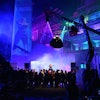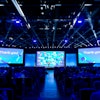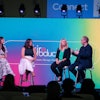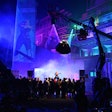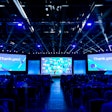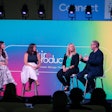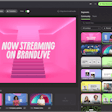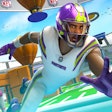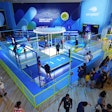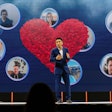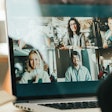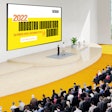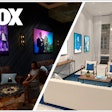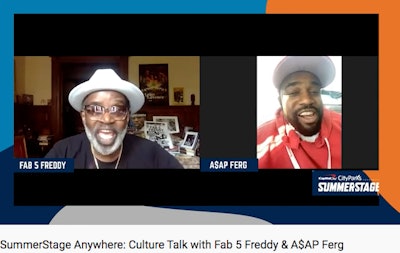
NEW YORK—Some festival organizers have attempted to convert a weekend-long event into a digital experience. But what about an entire summer’s worth of shows?
This year, Capital One City Parks Foundation SummerStage, a massive arts festival that usually boasts 80 to 100 live shows hosted in 15 to 18 parks around New York City’s five boroughs, is trying to do just that with its free digital series called SummerStage Anywhere.
Featuring a robust lineup of arts performances, panel discussions, meditation sessions, DJ sets, and more, both live and pre-recorded, the daily series tries to emulate a season of SummerStage by highlighting a range of genres that were born in or deeply represent New York, such as hip-hop, Latin, global, indie rock, jazz, and contemporary dance.
“We really wanted to stay in touch with our audience and make sure that SummerStage was still available to them no matter what was going on in the rest of the world,” explained Heather Lubov, executive director of the City Parks Foundation.
Typically, from September through March, the independent, not-for-profit organization is working on programming for the upcoming season. But with this quick pivot to digital, the team basically had to book the entire summer in about three weeks.
The series started with a weekly show in June and then ramped up in July, offering daily programming through mid-August.
“It's a very different experience for us. But music is music and dance is dance, and it translates. Even if it's not quite the same experience live, watching an artist talk about what inspires them and then listening to them perform, it's still an incredible feeling even if it’s not in person,” Lubov said.
Instead of simply offering the live shows via a digital format, Lubov and her team took a more thoughtful approach to programming and embraced an online strategy.
“Since we're programming every day, we wanted to change things up a little bit and an online environment gives you an opportunity to do something that feels more intimate,” she explained. “I think curator talks and talks between artists lend themselves to that kind of environment where it is more intimate and where people can interact and comment and chat. So we wanted to take advantage of the fact that we were going to be online and do things a little bit differently.”
This also meant exploring different social media platforms. The series is broadcast via Instagram, YouTube, Facebook, and Twitch channels.
“There are some platforms that are better than others for specific kinds of discussions or performances,” Lubov explained. For example, Twitch is preferred for DJ sets. She also said that the performances are shorter than usual. In-person shows can typically run three or four hours, but the digital shows are 30 minutes at most.
While some performers who were originally scheduled to appear at the in-person event were brought onboard the digital festival, others were additions that were able to participate because of the new digital-friendly lineup—such as DJ Kool Herc, who did a talk about the history of hip-hop.
Lubov said that the festival usually hosts a handful of panels every summer, but they can be limited. “You can only hold so many people, and in the digital world it's endless. Anyone can watch and comment, which is really interesting to us because we don't usually have that opportunity. So we wanted to mix it up and do a combination of live performance and interviews with artists.”
In addition to learning how to broadcast on social media channels, Lubov and her team also had to get accustomed to measuring success in terms of viewers as opposed to attendees. She said that, so far, viewership of the shows has been fairly comparable to a live show in Central Park, with 500 to 5,000 lifetime viewers tuning in. “When we do a show, we’re a 5,000-capacity venue, so we look to have 5,000 people and it doesn't work that way digitally because you can watch it anytime.”
Also, because of the extensive promotion across digital channels—something that the organization hadn’t done in the past—Lubov said that they’ve “seen a pretty significant increase in impressions for [title sponsor] Capital One” and that they are working on integrating cardholders more with special VIP experiences.
Even though the digital series is running full steam ahead, Lubov is still holding out hope that an in-person show might happen in the near future. She said her team has put together a series of safety protocols that would allow them to present a show safely, explaining that in Central Park they can control how many people come in and out and where they sit. Plus, the organization also has a mobile stage with sound gear that could be ready to go in a day or two.
“If things calm down a little bit and if we are allowed to do a live show before it gets cold, we'll be ready to do it and we’re really anxious to do it.” She said that she’s been in contact with NYC & Company, the city’s Department of Cultural Affairs, and the Department of Parks about the possibility of an in-person show, adding that it would be a small show with probably 200 people who are safely distanced.
But regardless of whether there’s an in-person show or not, Lubov said that digital is here to stay. “I very definitely think our business has changed. ... We've seen a pretty significant increase in the number of subscribers to our social media channels. Previously that was not our focus. Our focus was in-person live shows. But now that we're doing things digitally, we're building an audience that’s worldwide. I don't want to drop them at the end of August or September.”
She said that they plan to continue SummerStage digital performances throughout the year, possibly one show a week after the summer series ends. And that all in-person shows will be livestreamed going forward. “We have to completely change how we think about our programming as a result of it.”
